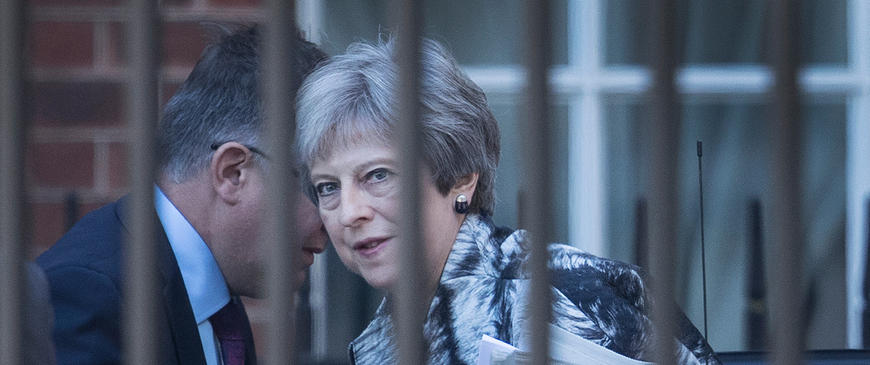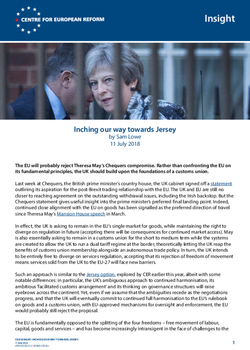
Inching our way towards Jersey
The EU will probably reject Theresa May’s Chequers compromise. Rather than confronting the EU on its fundamental principles, the UK should build upon the foundations of a customs union.
Last week at Chequers, the British prime minister’s country house, the UK cabinet signed off a statement outlining its aspiration for the post-Brexit trading relationship with the EU. The UK and EU are still no closer to reaching agreement on the outstanding withdrawal issues, including the Irish backstop. But the Chequers statement gives useful insight into the prime minister’s preferred final landing point. Indeed, continued close alignment with the EU on goods has been signalled as the preferred direction of travel since Theresa May’s Mansion House speech in March.
In effect, the UK is asking to remain in the EU’s single market for goods, while maintaining the right to diverge on regulation in future (accepting there will be consequences for continued market access). May is also essentially asking to remain in a customs union for the short to medium term while the systems are created to allow the UK to run a dual tariff regime at the border, theoretically letting the UK reap the benefits of customs union membership alongside an autonomous trade policy. In turn, the UK intends to be entirely free to diverge on services regulation, accepting that its rejection of freedom of movement means services sold from the UK to the EU-27 will face new barriers.
Such an approach is similar to the Jersey option, explored by CER earlier this year, albeit with some notable differences: in particular, the UK’s ambiguous approach to continued harmonisation, its ambitious ‘facilitated customs arrangement’ and its thinking on governance structures will raise eyebrows across the continent. Yet, even if we assume that the ambiguities recede as the negotiations progress, and that the UK will eventually commit to continued full harmonisation to the EU’s rulebook on goods and a customs union, with EU-approved mechanisms for oversight and enforcement, the EU would probably still reject the proposal.
The question therefore is not whether the EU will reject the UK’s proposal, but rather when.
The EU is fundamentally opposed to the splitting of the four freedoms – free movement of labour, capital, goods and services – and has become increasingly intransigent in the face of challenges to the international legal order, of which the EU is part, from Trump, Salvini, Orbán and Kaczyńsky. While it has carved out goods from its single market in the past – in the case of Switzerland – it appears unwilling to do so again. This is especially true if the UK is to reject free movement of people. Granting the UK such an agreement, sans free movement of people, could potentially embolden eurosceptic movements in other member-states, who could use it to assuage the economic concerns of manufacturing workers; and would also disturb the EU’s relationship with Switzerland and Norway.
The question therefore is not whether the EU will reject the UK’s proposal, but rather when. The Chequers statement potentially provides Theresa May the political cover she needs to get the withdrawal agreement and its Irish backstop over the line (although the spate of ministerial resignations following the statement being signed off suggest that even this might be tricky). The political statement on the future relationship that will accompany the withdrawal agreement may have political significance, but it will have no legal force. Therefore, the EU could choose to string out its contemplation of the Chequers proposal, buying breathing space for Theresa May, and reject it only after Britain has left, at a moment where May might have more room to compromise. In reality, the substance of the post-Brexit relationship will not be negotiated until after the UK has left the EU.
But if the EU is to shoot down Jersey, and Theresa May is unable to rub out any more red lines (particularly the one on free movement of people), what options are left? If the UK is to learn anything from the Swiss experience of near-permanent negotiation with the EU, it should be that it is folly to waste energy challenging the EU on its stated fundamental principles. Instead, it is better to accept the principle, and then do what you can with the flexibility afforded by the implementation, when the political scrutiny is less intense.
If the UK is to learn anything from the Swiss experience of near-permanent negotiation with the EU, it should be that it is folly to waste energy challenging the EU on its stated fundamental principles.
The EU has expressed a willingness to discuss a future EU-UK customs union, and, with votes on future Brexit legislation to come, it is still something Parliament could will the UK government to negotiate. But alone, a customs union only goes so far to reduce controls at the border. The main benefit of a customs union is that it removes the need for rules of origin. Whereas, under the terms of a free trade agreement, an exporter will need to demonstrate that the product they are selling is sufficiently local if it is to qualify for a preferential tariff rate, within a customs union the preferential rate is applied unconditionally. This comes with benefits – rules of origin checks can prove particularly burdensome for complex manufacturing sectors such as cars – but does not remove the need for import/export documentation, safety inspections and associated border checks.
To reduce border friction, the customs union agreement would need to be comprehensive, covering all traded goods inclusive of agriculture. It would also need to include commitments on the alignment of technical regulations, as is the case with the EU-Turkey customs union (although the UK would want to go much further). Most industrial goods are self-certified as compliant by the producer (although Brexit would shift the burden of compliance onto the EU-based importer and vice-versa) and, assuming the UK remains a member of the European Standards Organisations and applies the EU regulatory regime domestically, the frequency of physical inspections at the border would probably be low. For non-sensitive products that require a third party to certify they meet a European standard, the EU and UK will probably be able to mutually recognise each other’s conformity assessment bodies (which certify that products comply with regulation) as the EU has done with countries such as the US, Australia and Japan.
Such a supercharged customs union, or a customs union plus, would result in UK-based companies still facing additional bureaucratic hurdles – for instance, EU-based bodies may need to authorise and register certain sensitive products coming from the UK, such as chemicals. Further measures would need to be agreed to deal with the movement of truck drivers and other people involved in transport and distribution. Big questions remain regarding how much can be done with regard to food and plant health inspections (the biggest generator of checks at the border), VAT and the continued wavering of import/export declarations under such an approach. But loading regulatory elements into a customs union agreement might get the UK a small part of the way towards Jersey without ever uttering the toxic words ‘single market’. It would still probably require some sort of regulatory border between Northern Ireland (which the EU will allow to remain fully within the single market for goods due to its special circumstances) and the rest of the UK. That regulatory border already exists for the trade in live animals, but, importantly, it would not be a customs border.
So long as the UK is unwilling to erase its red lines altogether, it is difficult to foresee a landing zone that doesn’t leave the country significantly poorer than it would have been otherwise.
Brexit means increased red tape and costs for British businesses trading across the continent. So long as the UK is unwilling to erase its red lines altogether, it is difficult to foresee a landing zone that doesn’t leave the country significantly poorer than it would have been otherwise. Yet if a customs union could be negotiated and agreed following the UK’s departure in March 2019, and it was subsequently stuffed to the rafters with additional regulatory measures, it might offset some of the damage (although it is difficult to see how border friction could ever be obviated entirely under such an approach). For better or worse, the UK might find itself a little nearer to Jersey than the EU would explicitly countenance, but, for the UK and its producers, it still might not be near enough.
Sam Lowe is a senior research fellow at the Centre for European Reform.


Comments
First of all, by the time of Brexit it'll be clear to everybody that the real cruch time has just kicked off.
Secondly, the ratification of any future relationship includes then all EU27 + some regional parliaments.
It's either WTO (that is if it still exists at this point), Norway + CU or a Canada-style FTA. My money is on the latter.
Add new comment